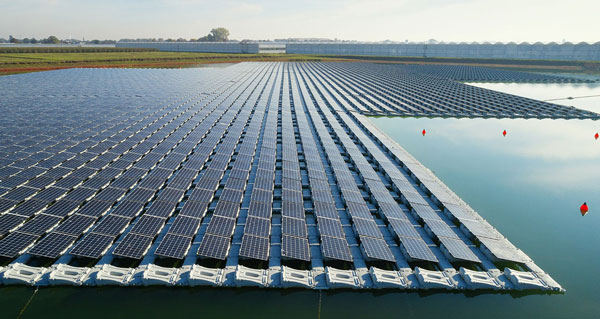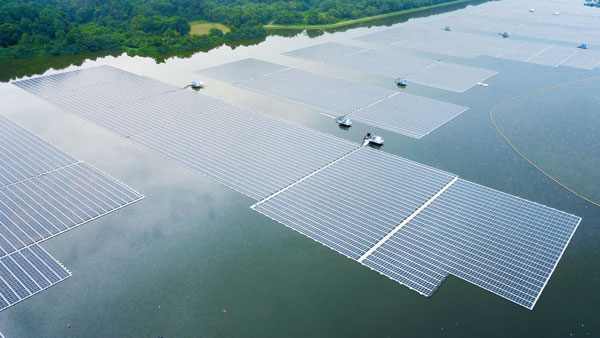6 Benefits Of Floating Solar Farms
2024-06-24
Conservation Of Land Resources
Thatis because floating solar farms,aggregates of photovoltaic systemsthat float on the surface of drinking water reservoirs, quarry lakes, lakes, irrigation canals, remediation and tailing ponds, have various advantages over standard solar power installations. Land conservation is a huge thing. They also can be used in places that are densely populated, in urban areas and in agricultural regions where the land might be more effectively used for food production. Floating solar panels save leading agricultural land, reduce water evaporation, and restrain algae growth within water bodies. A case-in-point would be the floating solar farm engineered on the waters of Tengeh Reservoir, Singapore, where hectares of panels not only supply the city with ample electricity but also plummet water wastage (from excessive evaporation) by a sizeable quantity. Efficient Use of Water Bodies Floating solar farms make use of underused water surfaces, it is a concept few capitalize on. This does not apply to all installations, the bigger the artificial reservoir or industrial basin, the bigger the wind power generator capacity they can be then apply, some of the biggest Italian basins were installed following this idea, enabling to provide wind power generators from a formerly power less zone. A 1.25 acre solar project in the state of Kerala in India generates the electricity needed for 200 homes, a prime example that illustrates how waterbodies can be used to generate energy without disturbing the ecosystem. Improved Solar Panels Cool TechF: Solar panels will be at their best if kept cool. Floating solar comes with natural water cooling effect providing a cooling effect to the solar panels which subsequently ensures that the temperature of the solar panels are at the lowest which in turn results in a well performing solar panel and a better energy output. This cooling effect can raise the efficiency of floating panels by up to 10% compared to land-based panels. Evidence of the potential was the showing of the floating solar farm at Queen Elizabeth II Reservoir near London where the efficiency was increasing due to the cooler panel temperatures. Less water evaporation Floating pv cells, can efficiently trauma water evaporation, are a hydro efficiency because of the truth they location sunlight regarding water. The panels reduce the amount of water lost to the atmosphere by blocking out larger expanses of water. This feature is very helpful in arid climates where conserving water becomes every important. By reducing the evaporation of annual water on land in Sonora, Mexico by up to 30% which is a real benefit in water poor regions like this. Co-location Benefits Floating solar and hydropower can increase the energy potential and reliability of resources at the same time. This natural synergies to produce a joint, solar photovoltaic power during the day and as a supplement, hydroelectric power can be generated when the sun is absent. In Lithuania, the Kruonis Pumped Storage Plant has employed this model which leads to a better utilization of solar as well as hydro resources by making energy production more efficient.
Reduction in Water Evaporation from Reservoirs
Floating solar farms dramatically lowers water evaporation among reservoirs and other water bodies. This results in significant reduced evaporation rates by preventing large surfaces to be sun exposed to water areas and at the same time cover them with photovoltaic panels. This saving of water is very important in drought areas or where water is a rare resource. One excellent example of this is the floating solar farm pilot on the Piolenc reservoir in France. It spans 17 hectares, and is expected to cut nearly 1,000 cubic metres a day of water evaporation in the height of summer. This is particularly advantageous for agricultural communities who depend on the water bodies to irrigate their farmlands. Impact on Local Water Levels Variation of the local water levels will show the diminished evaporation effect. At the Bhadla Solar Park in Rajasthan in India there are many small water bodies next to the park since the solar panels are floating gently on top of the lake.Making sure that the local water levels are more evenly distributed throughout the year. The area covered by these installations can contribute to a 70% reduction of evaporation, according to research conducted on these applications. Water Conservation is a Cost-Effective Floating solar farms are capital-intensive in its initial set-up but it will save a lot of revenue, particularly in water, whereever industries are consuming water extensively, and farming is the necessity. In agricultural applications in the California's Central Valley, water was saved at a price that recovered the cost of the initial setup of floating solar within just a couple of years. Enhanced Water Management Reduced evaporation from reservoirs = more responsible storage and distribution of water. In Nevada and other arid regions, officials made good use of this information by incorporating floating solar in their life-line infrastructure planning, which can increase water management efficiency and more stable/certain water availability through the year.Increased Efficiency Due to Cooling Effects
Floating solar farms can even take advantage of free natural cooling that improves the efficiency of the operation of the plant. By keeping the solar panels from over heating, water bodies cut off extra heat and cool down the system. Research has found the cooling effect can improve the efficiency of solar power generation by up to 16% over land-based panels. The solar panels at the Changhua Coastal Floating Solar Farm in Taiwan, the world's largest floating solar power plant, have an average lower temperature, compared to land-based installations of similar capacity.It has continually increased output by 12+% on the energy side, since the cooler panels all work better and generate more energy. Compare To Land-Based Solar Systems Cost comparisons from solar systems on water and land indicate that floating solar frequently delivers less expensive temperature coefficients. Floating solar panels at Japan's Yamakura Dam are always around 5 ºC (9°F) cooler than those on land. That difference in temperature translates into a 10% improvement in power output during peak sunlight hours. Less mileage less maintenance with better reliability That also reduces stress on solar panel embarking and other materials and helps the system serve for more time while reducing maintenance instances. Lianyungang China Floating Solar Maintenance data suggested 20% less frequency in comparison to the similar capacity land based installation mainly due to lower degradation as the temperatures are lower. Improvement Methods with regards to Cooling There are also plans to test additional ways to enhance the cooling properties for several floating solar farms. In Singapore entirely, a pilot project has active water circulation for both cooling the panels and to avoid algae growth, by keeping panel surfaces clean and efficient.Synergies with Hydroelectric Power
When employed in conjunction with reservoirs, floating solar farms offer a potent dual-energy strategy that makes the most of bodies of water. These systems take advantage of the common infrastructure and energy generation characteristics, meaning power output and reliability are improved considerably. The floating solar farm in Albania with the existing hydroelectric plant at the Banja Reservoir. Together, the solar panels and the hydroelectric facility are capable of creating electricity during sunny days, whereas the hydroelectric facility can work at night or overcast days. Output has risen 20%, without using any additional land or resources. Enhanced Grid Stability Solar and hydroelectric: These two complement each other to give a far greater degree of grid stability. Solar, as a source of power, stops working in the evenings and it is imported at periods after peak light hours, so the flexibility is limited, where as hydro electric resigns power in accordance with O-P-S (rise-off-set), so if the solar generation is less hydro electric can generate more power. Perhaps the grid balancing at the Kruonis Pumped Storage Plant in Lithuania serves as a broad example, highlighting that energy management can be a flexible, moving target. Water Resource Management Optimisation Hybrid operation of floating solar farm and hydroelectric power plant improves water resource utilisation. It is especially efficient in places that experience drought as it minimizes the need for water. The hybrid system installed at the Yingli Solar Park in China that not only delivers power but also slashes water evaporation in half, saving water resources for hydroelectric power and other uses. Socio-economic and Environmental Gains Floating solar and hydroelectric power combine economic and environmental benefits through the utilization of dam infrastructure. This eliminates the need for new build, and so is an environmental boon while being the most cost-effective. As demonstrated by projects such as that at Portugal's Alto Rabagão Dam, solar alongside hydro makes economic and longevity sense closing the circle of sustainable energy development.